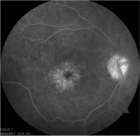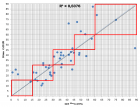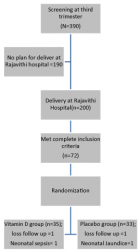Abstract
Research Article
Maternal and fetal outcome of comparative study between old & adopted new value of screening of Gestational Diabetes Mellitus in tertiary centre in Saudi Arabia
Gehan Farid*, Reem Mohammed Kamal*, Mohamed AH Swaraldahab and Sarah Rabie Ali
Published: 18 May, 2018 | Volume 1 - Issue 1 | Pages: 026-034
Objectives: To check if there is any significant difference in the immediate outcome of pregnancy with diabetes using the new values of FBS & 2hrs post prandial with 75g OGTT for 1 year (from 1st June 2013-31st May 2014) in comparison to the previous data done in the same institute with other values and with international figures.
The data in our study included fetal, maternal morbidities, intra partum and postnatal outcomes, in order to help, if possible, on deciding the best values to use for screening for gestational diabetes mellitus. Furthermore, to know the new percentages of gestational diabetes mellitus in SFH by utilizing the new values of Blood Sugar readings.
Design: Retrospective cohort study
Setting: Security Forces Hospital-Riyadh-Saudi Arabia
Patients: Done (from 1st June 2013 – 31st May 2014), on patients who had attended Security Forces Hospital, Riyadh, Saudi Arabia. This chosen year’s data was compared with data collected in the three previous years using different figures.
Main Outcome measured: Average age of mother, maternal aspects of parity, history of GDM, number of abortions``````````````````````````````, estimated blood loss in labor, associated medical disorder, complications of previous pregnancies, methods of control of GDM, gestational age for IOL and associated intrapartum complications. Immediate neonatal outcome in cases of GDM, comparison of birth weights of babies & any specific congenital abnormalities and delayed causes of admission to NICU in the 4 years studied were also reviewed.
Results: The percentage of diagnosed cases of gestational diabetes mellitus (GDM) after screening was 24 % as compared with 14.5% in previous study of 2003-2004 & with the number of screened patients amounting to 93% out of the total number of deliveries between 2013-2014 (in both years universal method of screening was used). The multidisciplinary set up of our GDM specialized clinic which was composed of dieticians, diabetic educators, endocrinologists and obstetric physicians operating together, helped to reduced the use of insulin in combination with diet to only 24% in comparison to 76% of patient using diet and exercise alone. The study showed a mean age of 33years and weight of 77kg. It was also noted that 16% of the patients diagnosed with GDM were multiparous averaging 1-5 deliveries. Almost 62% of patient didn’t give any history of GDM and no history of previous medical diseases. The majority of the patient with GDM delivered without complications during labor, with 30% having vaginal lacerations & 73% of patient had an estimated blood loss of less than 500cc. NICU admissions secondary to hyperbilirubinaemia averaged almost 17% in comparison to previous studies and only one baby expired in a GDM patient. Our study revealed a good fetal and maternal out come with less delivery complications and less incidence of postpartum hemorrhage (5.7%).
Conclusion: It is concluded that Universal Screening of Pregnant women whether with previously used glucose value or new ones for gestational diabetes mellitus is a better option, which has proven to improve both maternal and fetal outcomes. The 75 OGTT test is a cost effective test and with both easy accessibility and good screening pick up number (92.5%) of the patients in Security Forces Hospital, Riyadh.
Recommendation: We recommend annual follow up for patients, both the mother and the baby after postpartum, to prevent the development of type 2 diabetes.
Read Full Article HTML DOI: 10.29328/journal.cjog.1001005 Cite this Article Read Full Article PDF
References
- Schmidt A, Sivaraman J, Li Y, Larocque R, Barbosa JA, et al. Three-dimensional structure of 2-amino-3-ketobutyrate CoA ligase from Escherichia coli complexed with a PLP-substrate intermediate: inferred reaction mechanism. Biochemistry. 2001; 40: 5151-5160. Ref.: https://goo.gl/vG2tFJ
- Yin-Wong Cheung, Menzie D Chinn, Antonio Garcia Pascual. Empirical exchange rate models of the nineties: Are any fit to survive?. J Int Money Finance. 2005; 24: 1150-1175. Ref.: https://goo.gl/8bLCrj
- Bellamy L, Casas JP, Hingorani AD, Williams D. Type 2 diabetes mellitus after gestational diabetes: a systematic review and meta-analysis. Lancet. 2009; 373: 1773-1779. Ref.: https://goo.gl/v34PJX
- Naylor CD, Sermer M, Chen E, Sykora K. Cesarean delivery in relation to birth weight and gestational glucose tolerance: pathophysiology or practice style? Toronto Trihospital Gestational Diabetes Investigators. JAMA. 1996; 275: 1165-1170. Ref.: https://goo.gl/XydYDz
- Gillman MW, Oakey H, Baghurst PA, Volkmer RE, Robinson JS, et al. Effect of treatment of gestational diabetes mellitus on obesity in the next generation. Diabetes Care. 2010; 33: 964-968. Ref.: https://goo.gl/x8Rk3k
- Hillier TA, Ogasawara KK, Pedula KL, Vesco KK. Markedly different rates of incident insulin treatment based on universal gestational diabetes mellitus screening in a diverse HMO population. Am J Obstetric Gynecol. 2013; 209: 1-9. Ref.: https://goo.gl/KKZgec
- Langer O, Rodriguez DA, Xenakis EMJ, McFarland MB, Berkus MD, et al. Intensified versus conventional management of gestational diabetes. AM J Obstetrics Gynecol. 1994; 170: 1036-1047. Ref.: https://goo.gl/VdL2gM
- Rehder PM, Pereira BG, Pinto e Silva JL. The prognostic value of a normal oral glucose tolerance test in pregnant women who tested positive at screening: A validation study. Diabetology & Metabolic Syndrome. 2012; 4: 10. Ref.: https://goo.gl/f4RSUj
- Wendland EM, Duncan BB, Mengue SS, Schmidt MI. Lesser than diabetes hypoglycemia in pregnancy is releated to perinatal mortality: a cohort study in Brazil. BMC Pregnancy and Childbirth. 2011; 11: 92. Ref.: https://goo.gl/WrbgyK
- Ramtoola S, Home P, Damry H, Husnoo A, Ah-Kion S. Gestational impaired glucose, tolenace does not increase perinatal mortality in a developing country: cohort study. BMJ. 2001; 322: 1025. Ref.: https://goo.gl/iSrjmb
- Griffin ME, Coffey M, Johnson H, Scanlon P, Foley M, et al. Universal vs. risk factor-based screening for gestational diabetes mellitus: detection rates, gestation at diagnosis and outcome. Diabet Med. 2000; 17: 26-32. Ref.: https://goo.gl/xuyydj
- Farrar D, Fairley L, Wright J, Tuffnell D, Whitelaw D, et al. Evaluation of the Impact of universal testing for gestational diabetes mellitus on maternal and neonatal health outcomes: A retrospective analysis. BMC Pregnancy and Childbirth. 2014; 14: 317. Ref.: https://goo.gl/zhafpx
- Danyliv A, Gillespie P, O’Neill C, Tierney M, O’Dea A, et al. The cost-effectiveness of screening for gestational diabetes mellitus in primary and secondary care in the Republic of Ireland. Diabetologia. 2015; 59: 436-444. Ref.: https://goo.gl/LZtmRU
- Yang X, Tian H, Zhang F, Zhang C, Li Y, et al. A randomized translational trial of lifestyle intervention using a 3 tier shared care approach on pregnancy outcomes in Chinese women with gestational diabetes mellitus but without diabetes. J Transl Med. 2014; 12: 290. Ref.: https://goo.gl/dDwxvG
- Werner EF, Pettker CM, Zuckerwise L, Reel M, Funai EF, et al. Screening for Gestational Diabetes Mellitus: Are the criteria Proposed by the International Association of the Diabetes and Pregnancy Study Groups Cost-Effective?. Diabetes Care. 2012; 35: 529-535. Ref.: https://goo.gl/dqEPnf
- Turok DK, Ratcliffe SD, Baxley EG. Management of Gestational Diabetes Mellitus. American Family Physician. 2003; 68: 1767-1772. Ref.: https://goo.gl/dkTx6C
- Karagiannis T, Bekiari E, Manolopoulos K, Paletas K, Tsapas A. Gestational Diabetes Mellitus: Why screen and how to diagnose. Hippokratia. 2010; 14: 151-154. Ref.: https://goo.gl/C4XkCC
- National Diabetes Data Group. Diabetes in America, 2nd ed. Behesda, MD: National Institute of Health. 1995. Ref.: https://goo.gl/Lcw14L
- Metzger BE, Lowe LP, Dyer AR. Hyperglycemia and Adverse Pregnancy Outcomes. The HAPO Study Cooperative Research Group. N Engl J Med. 2008; 358: 1991-2002. Ref.: https://goo.gl/BcZPJT
- American Diabetes Association. Position statement: Standards of Medical Care in Diabetes- 2012. Diabetes Care. 2012; 35: 511-563.
- Diagnosis and Classification of Diabetes Mellitus. Diabetes Care. 2010; 33: 62-69. Ref.: https://goo.gl/BnxWC8
Similar Articles
-
TMD and pregnancy?Afa Bayramova*. TMD and pregnancy?. . 2018 doi: 10.29328/journal.cjog.1001001; 1: 001-006
-
Is It Possible to End Female Circumcision in Africa?Fiona Dunn*. Is It Possible to End Female Circumcision in Africa? . . 2018 doi: 10.29328/journal.cjog.1001002; 1: 007-013
-
Screening of Gestational diabetes mellitusGehan Farid*,Sarah Rabie Ali*,Reem Mohammed Kamal. Screening of Gestational diabetes mellitus . . 2018 doi: 10.29328/journal.cjog.1001003; 1: 014-023
-
The Case of the Phantom Trophoblastic TumorBenedict B Benigno*. The Case of the Phantom Trophoblastic Tumor. . 2018 doi: 10.29328/journal.cjog.1001004; 1: 024-025
-
Maternal and fetal outcome of comparative study between old & adopted new value of screening of Gestational Diabetes Mellitus in tertiary centre in Saudi ArabiaGehan Farid*,Reem Mohammed Kamal*,Mohamed AH Swaraldahab,Sarah Rabie Ali. Maternal and fetal outcome of comparative study between old & adopted new value of screening of Gestational Diabetes Mellitus in tertiary centre in Saudi Arabia. . 2018 doi: 10.29328/journal.cjog.1001005; 1: 026-034
-
Small cell carcinoma of the ovary with hypercalcemia: Case report and review of the literatureGerday A*,Marbaix E,Squifflet JL,Mazzeo F,Luyckx M. Small cell carcinoma of the ovary with hypercalcemia: Case report and review of the literature. . 2018 doi: 10.29328/journal.cjog.1001006; 1: 035-044
-
Perinatal Morbidity & Mortality following repeat Cesarean section due to five or more previous Cesarean Section done in Tertiary centre in KSASomia Osman,Gehan Farid*,Reem Mohamed Kamal,Sarah Rabie Ali,Mohamed AH Swaraldahab. Perinatal Morbidity & Mortality following repeat Cesarean section due to five or more previous Cesarean Section done in Tertiary centre in KSA. . 2018 doi: 10.29328/journal.cjog.1001007; 1: 045-051
-
A Rare case of synchronous primary malignancies of gall bladder and ovaryRidhi Narang*,T Das,M Dagar,M Srivastava,S Bhalla,I Ganguli. A Rare case of synchronous primary malignancies of gall bladder and ovary. . 2018 doi: 10.29328/journal.cjog.1001008; 1: 052-055
-
Effectiveness of the lifestyle modifications in prevention and control of sexually transmitted diseases (STDs): Focus on Islamic lifestyleMohammad Rabbani Khorasgani*. Effectiveness of the lifestyle modifications in prevention and control of sexually transmitted diseases (STDs): Focus on Islamic lifestyle. . 2018 doi: 10.29328/journal.cjog.1001009; 1: 056-057
-
Septic arthritis of left shoulder in pregnancy following minor hand injuryNeelam Agrawal,Rhoughton Clemmey,Shamma Al-Inizi*. Septic arthritis of left shoulder in pregnancy following minor hand injury. . 2018 doi: 10.29328/journal.cjog.1001010; 1: 058-060
Recently Viewed
-
Fiesta vs. Stress Condition the Incidence and the Age at Menarche. Forty Years of ResearchCarlos Y Valenzuela*. Fiesta vs. Stress Condition the Incidence and the Age at Menarche. Forty Years of Research. Clin J Obstet Gynecol. 2025: doi: 10.29328/journal.cjog.1001190; 8: 069-073
-
The Bacteriological Profile of Nosocomial Infections at the Army Central Hospital of BrazzavilleMedard Amona*,Yolande Voumbo Matoumona Mavoungou,Hama Nemet Ondzotto,Benjamin Kokolo,Armel Itoua,Gilius Axel Aloumba,Pascal Ibata. The Bacteriological Profile of Nosocomial Infections at the Army Central Hospital of Brazzaville. Int J Clin Microbiol Biochem Technol. 2025: doi: 10.29328/journal.ijcmbt.1001032; 8: 009-022
-
Parents’ perception of the school nurse’s roleDiane Gillooly*,Ganga Mahat,Patricia Paradiso. Parents’ perception of the school nurse’s role. J Adv Pediatr Child Health. 2020: doi: 10.29328/journal.japch.1001021; 3: 064-067
-
A girl with a stiff neckG Carlone*,A Prisco,F Vittoria,E Barbi,M Carbone. A girl with a stiff neck. J Adv Pediatr Child Health. 2020: doi: 10.29328/journal.japch.1001019; 3: 058-060
-
A rare case of acute necrotising pancreatitis in a paediatric patientLizeri Jansen*,Gabrielle Colleran,Ikechukwu Okafor,Nuala Quinn. A rare case of acute necrotising pancreatitis in a paediatric patient. J Adv Pediatr Child Health. 2020: doi: 10.29328/journal.japch.1001020; 3: 061-063
Most Viewed
-
Feasibility study of magnetic sensing for detecting single-neuron action potentialsDenis Tonini,Kai Wu,Renata Saha,Jian-Ping Wang*. Feasibility study of magnetic sensing for detecting single-neuron action potentials. Ann Biomed Sci Eng. 2022 doi: 10.29328/journal.abse.1001018; 6: 019-029
-
Evaluation of In vitro and Ex vivo Models for Studying the Effectiveness of Vaginal Drug Systems in Controlling Microbe Infections: A Systematic ReviewMohammad Hossein Karami*, Majid Abdouss*, Mandana Karami. Evaluation of In vitro and Ex vivo Models for Studying the Effectiveness of Vaginal Drug Systems in Controlling Microbe Infections: A Systematic Review. Clin J Obstet Gynecol. 2023 doi: 10.29328/journal.cjog.1001151; 6: 201-215
-
Causal Link between Human Blood Metabolites and Asthma: An Investigation Using Mendelian RandomizationYong-Qing Zhu, Xiao-Yan Meng, Jing-Hua Yang*. Causal Link between Human Blood Metabolites and Asthma: An Investigation Using Mendelian Randomization. Arch Asthma Allergy Immunol. 2023 doi: 10.29328/journal.aaai.1001032; 7: 012-022
-
Impact of Latex Sensitization on Asthma and Rhinitis Progression: A Study at Abidjan-Cocody University Hospital - Côte d’Ivoire (Progression of Asthma and Rhinitis related to Latex Sensitization)Dasse Sery Romuald*, KL Siransy, N Koffi, RO Yeboah, EK Nguessan, HA Adou, VP Goran-Kouacou, AU Assi, JY Seri, S Moussa, D Oura, CL Memel, H Koya, E Atoukoula. Impact of Latex Sensitization on Asthma and Rhinitis Progression: A Study at Abidjan-Cocody University Hospital - Côte d’Ivoire (Progression of Asthma and Rhinitis related to Latex Sensitization). Arch Asthma Allergy Immunol. 2024 doi: 10.29328/journal.aaai.1001035; 8: 007-012
-
An algorithm to safely manage oral food challenge in an office-based setting for children with multiple food allergiesNathalie Cottel,Aïcha Dieme,Véronique Orcel,Yannick Chantran,Mélisande Bourgoin-Heck,Jocelyne Just. An algorithm to safely manage oral food challenge in an office-based setting for children with multiple food allergies. Arch Asthma Allergy Immunol. 2021 doi: 10.29328/journal.aaai.1001027; 5: 030-037

If you are already a member of our network and need to keep track of any developments regarding a question you have already submitted, click "take me to my Query."

















































































































































